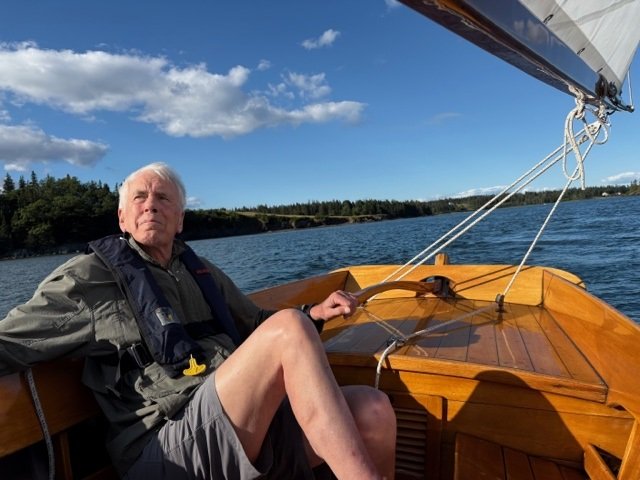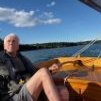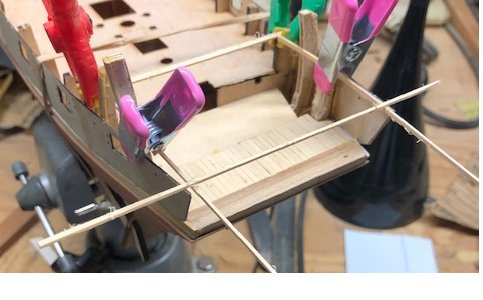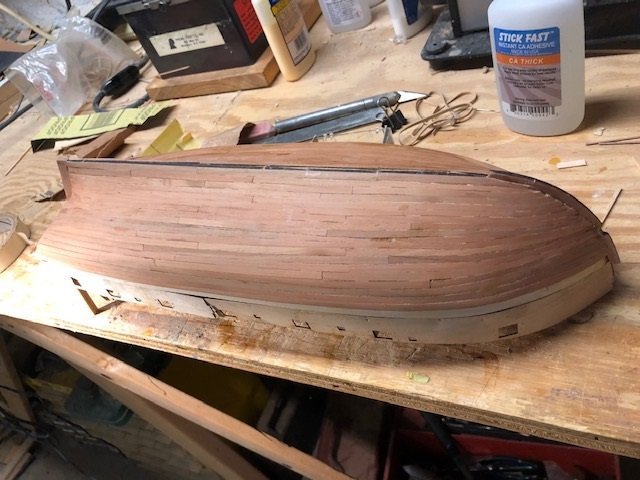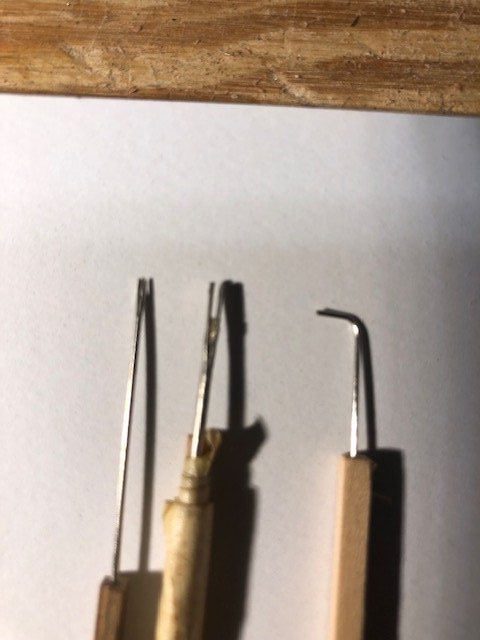-
Posts
1,305 -
Joined
-
Last visited
Content Type
Profiles
Forums
Gallery
Events
Everything posted by TBlack
-
Great cabin deck planked. The crazy arrangement of sticks in the picture is verifying that everything is square and that there is about 5'7'' headroom between quarterdeck beams. We know from the book that Aubrey could only stand fully up between the beams. Also the sticks are telling me that the quarterdeck will, in fact, hit the transom just as I had designed it. This is all working out much better that I could have expected. I thought about what kind of treatment for the cabin deck, and was inspired by Greg Herbert's treatment of the deck in Speedwell which, with its multiple carvings, is a much snappier craft than humble Sophie. Tom
- 341 replies
-
- Sophie
- Vanguard Models
-
(and 1 more)
Tagged with:
-
Bit of an up-date: Second planking installed, albeit slowly. Not my favorite part of the construction.: Having done that, I think I'm going to work on the captain's cabin next. It would be nice to see the other side of this vessel for a while. Tom
- 341 replies
-
- Sophie
- Vanguard Models
-
(and 1 more)
Tagged with:
-
Keith, Shouldn't "toffs" be capitalized? In any event, the way you tell the real sailors is look at their shoes. Wellies work well; on this side of the pond we do topsiders. Tom
-
Tom, I'm following you closely on this, as I have to do it with my HMS Sophie build (for the first time) Tom
- 200 replies
-
- Whaling Bark
- Charles W Morgan
-
(and 1 more)
Tagged with:
-
- 3,560 replies
-
- clipper
- hull model
-
(and 2 more)
Tagged with:
-
Tom, What kind of wood did you use to prevent crumbling at that small size?
- 200 replies
-
- Whaling Bark
- Charles W Morgan
-
(and 1 more)
Tagged with:
-
Tom, the reinforcements around the chock holes are particularly neat and uniform. What's the trick? Tom
- 200 replies
-
- Whaling Bark
- Charles W Morgan
-
(and 1 more)
Tagged with:
-
I know, but gives such insight to the author.
- 3,560 replies
-
- clipper
- hull model
-
(and 2 more)
Tagged with:
-
I don't even want to think about why a surgeon would need an 18" clamp.
- 3,560 replies
-
- clipper
- hull model
-
(and 2 more)
Tagged with:
-
Whoa! Looks fantastic! Very crisp. Tom
- 200 replies
-
- Whaling Bark
- Charles W Morgan
-
(and 1 more)
Tagged with:
-
Keith, I'm reminded of the 3 test rule: 10' away, 3' away, right up close. From your photos, it looks like "right up close"; still looks good! Tom
-
David, Did you notice that Vanguard (Chris) now sells a hull, completely formed, with ribs, so all you have to do is add the interior? In my Sophie build, which is based on Speedy, I'm tempted to just buy the hull. Yours turned out exceptionally well, but it's a bugger to get just right. BTW, That mouse turned out really well. Gotta try it! Tom
- 91 replies
-
- Speedy
- Vanguard Models
-
(and 1 more)
Tagged with:
-
Looks pretty good to me. Also, the deck color came out well. Making good progress! Tom
- 200 replies
-
- Whaling Bark
- Charles W Morgan
-
(and 1 more)
Tagged with:
-
Kev, I'm not sure what you mean by "seized twice". Do you mean is the shroud wrapped around the deadeye and then seized just at the deadeye and then farther up the shroud? And, of course, there are no shrouds at the bowsprit, just stays and no deadeyes. Tom
-
Looks good, bro. Never thought about lacing deadeye lanyards off the model. Gotta try it! Tom
-
Before I can place the garboard, I have to thin down the back end of the profile former (false keel to some). With the addition of the primary planking, that area is now 7 mm thick and needs reducing to 1.5 mm which also means more feathering of the hull to produce a smooth flow. Having done that, I notice that Chris doesn't expect me to install a garboard stake. I suspect it's because all the planks in the kit are of a uniform width. Nevertheless, I will press on: Looks the same on the other side. I'm using 24 foot planks. It also occurs to me that because the planks are all the same width that there will be stealers aft. Tom
- 341 replies
-
- Sophie
- Vanguard Models
-
(and 1 more)
Tagged with:
-
Nipper! Thanks so much for your kind words. I guess I've shown that one doesn't need fancy CAD programs to get a smooth result. Also, my last project (Scud) was greeted with some derision (why bother? Waste of time and talent) until the end (see log). Moral of the story? Don't rush to judgment. Anyway, you and the other 18 people who are following this keep me going and trying my best. Thanks for that. Gregory, I intend to do just what you suggest: 5 real windows and 2 fake. That arrangement will agree with the picture of the stern of the cover of the book. We had some discussion here on the impossibility of having 7 windows in the cabin given what the picture shows of the hull shape (please see post #84), and certainly there are no quarter galleries. Thanks, also, to the others for the "likes", especially my brother, Keith, whose talents and encouragement keep me going! Tom
- 341 replies
-
- Sophie
- Vanguard Models
-
(and 1 more)
Tagged with:
-
Small up-date, but life sometimes interferes with ship building: Having built the hull to its new configuration, I'm now trying to follow Chris Watton's excellent instructions on building out the model. One deviation is the placement of the wale, which I think I've figured out to my satisfaction: I only, belatetdly, realized that I don't need to make the wale out of the very nice pear wood supplied, inasmuch as it gets painted black in the end. Next layer will be something less grand. Next step is the garboard and then figure out the plank spacing in between. Tom
- 341 replies
-
- Sophie
- Vanguard Models
-
(and 1 more)
Tagged with:
About us
Modelshipworld - Advancing Ship Modeling through Research
SSL Secured
Your security is important for us so this Website is SSL-Secured
NRG Mailing Address
Nautical Research Guild
237 South Lincoln Street
Westmont IL, 60559-1917
Model Ship World ® and the MSW logo are Registered Trademarks, and belong to the Nautical Research Guild (United States Patent and Trademark Office: No. 6,929,264 & No. 6,929,274, registered Dec. 20, 2022)
Helpful Links
About the NRG
If you enjoy building ship models that are historically accurate as well as beautiful, then The Nautical Research Guild (NRG) is just right for you.
The Guild is a non-profit educational organization whose mission is to “Advance Ship Modeling Through Research”. We provide support to our members in their efforts to raise the quality of their model ships.
The Nautical Research Guild has published our world-renowned quarterly magazine, The Nautical Research Journal, since 1955. The pages of the Journal are full of articles by accomplished ship modelers who show you how they create those exquisite details on their models, and by maritime historians who show you the correct details to build. The Journal is available in both print and digital editions. Go to the NRG web site (www.thenrg.org) to download a complimentary digital copy of the Journal. The NRG also publishes plan sets, books and compilations of back issues of the Journal and the former Ships in Scale and Model Ship Builder magazines.

